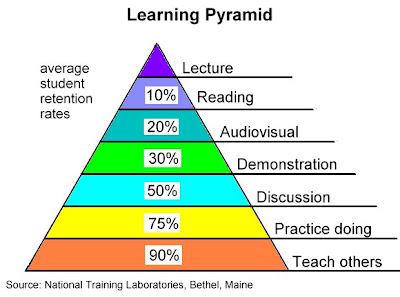If you're a teacher, whether at the elementary or up through the college level, or even beyond if you provide training at the corporate level, did you ever wonder what it really takes to drive home the lessons of what you're trying to teach to your students?
Is is enough to just lecture on a topic? Maybe throw in a reading assignment or two and also a video presentation? How much of what you're trying to teach will your students retain?
We stumbled across the following chart which graphically illustrates how effective various teaching methods are in helping students absorb the material that they're being taught (HT: Mike Bergman):

The "learning pyramid" above pretty effectively shows what methods work best for teaching students in a way that they really gain and retain the knowledge of what your teach.
As we can see, lecturing on a topic is probably the least effective method of teaching, as students only retain 0 to 10% of the material that they're taught. Moving up the scale, we see that reading assignments bring the information that students retain up to 10%, and that nifty audio-visual presentation can take student learning up to a level where they can effectively retain 20% of what they've been taught.
For most teachers, this is as far as they ever get. Is that enough for your students? Are your students now prepared to actively apply what you've just taught them in the real world?
Would you trust them with important responsibilities where they have to execute what you've just taught them?
Let's keep going up the scale to see what works better. That old saying "seeing is believing" is driven home at the next level up, where we find that providing a demonstration of what you teach can increase the percentage of what your students remember of what you teach to 30%.
If you'd like for them to remember at least half of what you teach, it might help to actually get them talking about it!
Can get your students to remember 75% of what you teach? Probably not unless you incorporate "hands-on" activities into your lesson plans. There's a reason why the saying "practice makes perfect" exists, after all.
But if you really want your students to really master what your trying to teach, you won't hit anywhere near the pinnacle of educator success unless and until you can teach them to teach what you're teaching them! This "teaching effect" is the single most effective method of getting students to really learn the subject matter at hand, allowing your students to effectively retain 90% of what they learn.
Now would you trust your students with real-life responsibilities for putting what you've been teaching to work? Probably yes, because now, you know that your students know pretty much everything you know.
And by having descended the learning pyramid, you can now call yourself a highly effective teacher!
Welcome to the blogosphere's toolchest! Here, unlike other blogs dedicated to analyzing current events, we create easy-to-use, simple tools to do the math related to them so you can get in on the action too! If you would like to learn more about these tools, or if you would like to contribute ideas to develop for this blog, please e-mail us at:
ironman at politicalcalculations
Thanks in advance!
Closing values for previous trading day.
This site is primarily powered by:
CSS Validation
RSS Site Feed
JavaScript
The tools on this site are built using JavaScript. If you would like to learn more, one of the best free resources on the web is available at W3Schools.com.